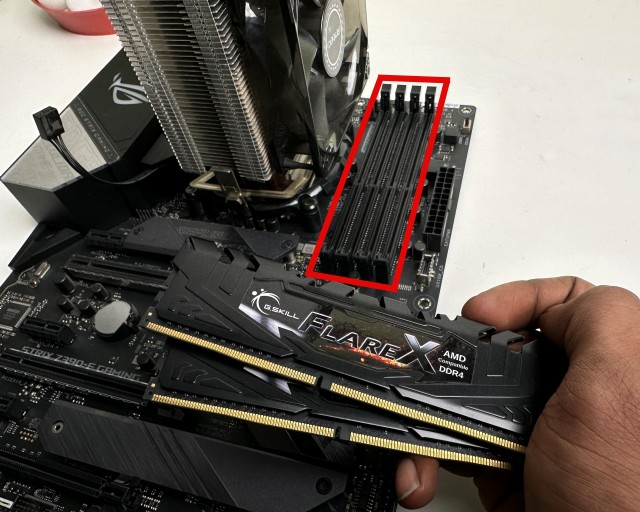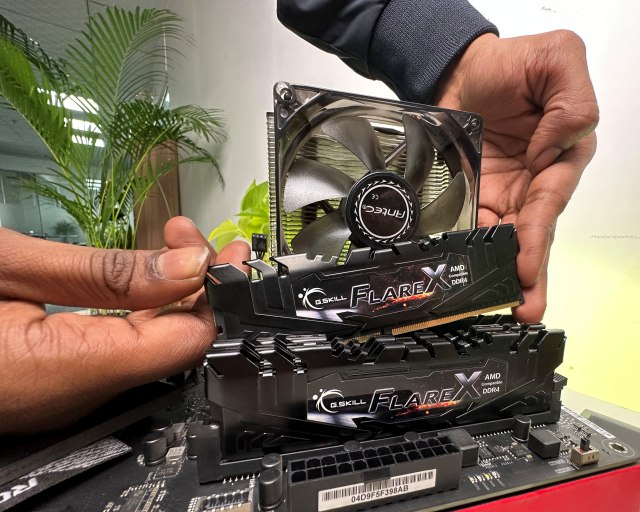RAM, or Random Access Memory, is a crucial component that you need to install in your PC build. For those unaware, RAM is utilized for storing data on a temporary basis and helps your computer run smoothly. The RAM loses all data stored within it when you shut down the PC. With the basics out of the way, you are here to learn how to install RAM sticks on a motherboard in your PC build. Installing RAM on a motherboard is a relatively simple process, and it can help extend the lifespan of your PC if you’re upgrading the RAM of an existing build. That said, let’s not waste time and learn how to efficiently install RAM on your motherboard.
In this article, we will help you identify the memory slots where you need to install the RAM. We will explain how to precisely line up your RAM sticks with the memory slots, which is the primary concern for many first-time PC builders. With that, let’s first look at all the things you need to take care of before the installation process.
Things to Remember Before Installing RAM
Check RAM Compatibility With Your Motherboard
To check what RAM is compatible with your motherboard, you need to go to the motherboard manufacturer’s website and check the QVL list as well as the supported memory type. We have personally observed our Ryzen APU-based system crash randomly with a DDR4 RAM module that wasn’t on the list and wasn’t designed for AMD computers either, even though it was physically supported on our B450 motherboard. Make sure to buy RAM sticks that are compatible with your motherboard.
There are many Intel Raptor Lake and Alder Lake motherboards, such as the Z690 and Z790, that have DDR5 RAM support, which is a lot faster than DDR4. Moreover, AMD’s latest-generation Ryzen 7000 CPUs and AM5 motherboards exclusively support only DDR5 memory. They are clearly moving on from DDR4 memory, but Intel still gives you a choice between DDR4 and DDR5. You can read more about the same in our dedicated Intel 13th-Gen i-13900K review.
Ensure Your RAM Sticks Run In Dual or Quad Channel Configuration
Next, make sure to get at least two of the same modules when you buy RAM. In case you are planning to install even more memory, refer to your motherboard manual to check how many available slots you have, and buy an even number of RAM sticks — 2 or 4. We have compiled a list of the best DDR4 RAM sticks you can buy for your workstation or gaming PC right now. To guide you through the optimal installation, motherboards sometimes color code the DIMM slots as well.
As for why you shouldn’t use an odd number of RAM sticks in your PC, it’s because they won’t run in the optimal configuration. You must always install RAM such that it supports Dual or Quad Channel configuration. Go through our guide to understand the advantages of dual-channel versus single-channel. Thus, buying two of the same RAM sticks (with the same latencies and frequencies) or a memory kit with multiple RAM modules is recommended.
How to Install RAM Sticks on Motherboard
Note: To avoid static damage to your PC components, we recommend you use an anti-static bracelet and ground yourself. You may also touch a metal object to discharge the static electricity in your body.
1. First, get your RAM sticks and the motherboard ready. You should rest the motherboard on top of its box during this tutorial. If you are upgrading your existing build, position the PC case horizontally to start the process.

2. Next, locate the RAM slots on your motherboard. Usually, they are located to the right of the CPU socket on the motherboard. These slots also have labels, which you can note down. Then, refer to your motherboard’s manual to confirm which RAM slots to use for optimal dual-channel or quad-channel support. Basically, if you have two or four RAM sticks, installing them in the specific slots that support dual- or quad-channel memory is the best-performing configuration.
Note:
Never install multiple sticks of RAM without confirming their proper installation slots with your motherboard manual. Otherwise, they will run at a slower single-channel configuration.

3. Next, you need to open the RAM slots on your motherboard. To do this, simply press outwards on your RAM slot’s tabs, so that they open up (as shown in the image below). Don’t apply too much pressure, and be careful to avoid breaking the RAM slot tabs. In many modern motherboards, only one side of the RAM tab tends to open up.

4. Next, line up the RAM module with the slot to visually understand which orientation to install it in. All RAM modules, be it DDR4 or DDR5, have a notch in the middle, which ensures you can insert the memory sticks only one way. Now, you not only need to line up the notch but also make sure the RAM sits comfortably into the gaps on each side of the slot.

5. Now, place your RAM into the slot (without completely pushing it in). Once you feel the placement is correct, take both your thumbs and gently press down on opposite ends of the RAM module. The RAM will press down into the slot and the tabs we opened earlier will now close automatically, locking the memory module in place. You will hear a click sound when the tabs close and the RAM modules are all perfectly installed.

6. Next, repeat these steps for all your other RAM modules. Your RAM sticks should be firmly seated in the slots as long as the orientation is correct. And voila! You have successfully installed RAM on your motherboard.

That’s pretty much everything you need to know about installing or upgrading the RAM in your PC build. By following the steps outlined in this guide, we hope you were successfully able to install your RAM sticks on your motherboard. Remember to carefully select the right type and amount of RAM for your PC build, so you can enjoy a faster and more efficient computing experience without any troubles. While RAM is not designed or intended to hold any storage, you can actually create a RAM Disk in Windows 10/11 using this guide. Moreover, if you’re facing any issues during installation, let us know in the comments below, and we will get back to you.
DDR5 is speedier than DDR4, but it is also more expensive. For a modern and future-proof PC, DDR5 is definitely the way to go. As for PC users on a tight budget, the DDR4 RAM market is quite mature, and you can get two RAM modules at a decent price. Also, you won’t notice a significant difference between DDR4 and DDR5 RAMs, especially in performance. So, you can go with DDR5 if you’re aiming for a future-proof system, but it’s otherwise fine to stick with DDR4 RAM.
RAM is supposed to go in the memory slots defined by your motherboard manufacturer. In some motherboards, the optimal configuration involves spacing out your memory modules and installing them in alternate slots. In some others, you have to install the RAM next to each other.
If your new RAM is compatible with your motherboard, then yes, you can simply plug in the new RAM modules and breathe new life into a PC build. Though, remember that a BIOS reset is automatically triggered by your motherboard whenever new components are installed.
DDR5 and DDR4 RAM are both different generations and have different ways of installation. Hence, DDR5 RAM is not compatible with a DDR4 slot.
The applications you run will define the amount of RAM you need. As a general rule of thumb, 16GB is a sufficient amount of RAM to have in modern PCs. You definitely need 8GB as a minimum, considering we are entering 2023. Many enthusiasts claim that 32GB makes a big difference, and you can surely multitask a lot with that much RAM.
It depends on your computer. If the current operating system is running slow and there are system hangups when running all the apps you desire, upgrading the RAM is an efficient way to ensure apps can run properly and make the OS feel snappier.






